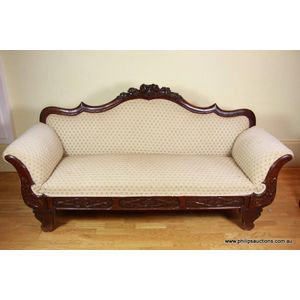Victorian Pink Velvet Chaise Longue
You must be a subscriber, and be logged in to view price and dealer details.
Subscribe Now to view actual auction price for this item
When you subscribe, you have the option of setting the currency in which to display prices to $Au, $US, $NZ or Stg.
- Ogee - A serpentine shape, usually convex at the upper part, concave at the lower. Mostly used to describe the front shapes of parts of carcass furniture, such as cornices, drawer fronts and feet.
- Acanthus - A stylized leaf motif, one of the primary decorative elements of classical Greek and Roman architecture, derived from the genus of flowering plants in the family Acanthaceae, native to tropical and subtropical regions of the Mediterranean area. It is a common element in classical Greek and Roman design, and is often seen in Corinthian and Composite order columns and used as a decorative element in English, European and Australian furniture, particularly on the curve of a leg, and as decoration for a corbel.
- Victorian Period - The Victorian period of furniture and decorative arts design covers the reign of Queen Victoria from 1837 to 1901. There was not one dominant style of furniture in the Victorian period. Designers used and modified many historical styles such as Gothic, Tudor, Elizabethan, English Rococo, Neoclassical and others, although use of some styles, such as English Rococo and Gothic tended to dominate the furniture manufacture of the period.
The Victorian period was preceded by the Regency and William IV periods, and followed by the Edwardian period, named for Edward VII (1841 ? 1910) who was King of the United Kingdom and the British Dominions and Emperor of India for the brief period from 1901 until his death in 1910. - Rail - A term used by cabinet makers for the horizontal sections of the frame of an item such as a chair or settee which have a front rail, a back rail and two side rails, and also on a door or carcase, where the rails are joined to the vertical framings.
- Serpentine - Resembling a serpent, in the form of an elongated 'S'. A serpentine front is similar to a bow front, except that the curve is shallow at each end, swelling towards the middle. The term presumably derives from its similarity to a moving snake or serpent. Serpentine fronts are usually veneered, with the carcase either being cut and shaped from a solid piece of timber, or built in the 'brick' method.
- Cresting - The decorative carving at the top of a piece of furniture, such as a sideboard back, a mirror, or a chair back.
This item has been included into following indexes:
Visually similar items

An early Victorian mahogany sofa with scrolled showwood arms, shaped back and turned legs. The seat with a squab and baluster cushions. Height 96 cm. Width 233 cm. Depth 70 cm

A Victorian mahogany framed chaise longue, circa 1860s, with a scrolled showframe and a floral crest, rounded and padded arms with a relief carved seating rail and raised on square form cabriole legs; upholstered in cream floral fabric with a rose and latt

William IV mahogany sofa scroll moulded back rail with floral centre on fluted down swept arms and turned legs

Colonial cedar Settlers couch. Shaped backboard; turned legs; upholstered seat and bolster. Height 94 cm. Length 215 cm. Depth 63 cm
